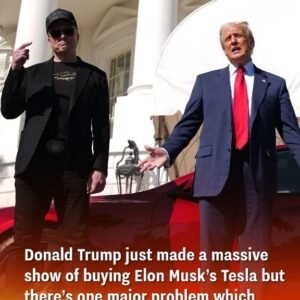In a striking public announcement, former President Donald Trump declared his intention to purchase a Tesla vehicle from Elon Musk, igniting a flurry of discussion and debate. This declaration, made during an official event at the White House and shared on his social media platform, Truth Social, was interpreted as both a show of support for Musk’s innovative company and a strategic political maneuver aimed at energizing his base. However, the announcement was not without its controversies; Trump revealed that he would not be driving the car himself, leaving many observers perplexed. This article delves into the implications of Trump’s announcement, exploring the intersection of politics, corporate endorsement, and public perception.
The relationship between politics and corporate endorsements has become increasingly prominent in contemporary society. Politicians often align themselves with successful businesses to signal their commitment to innovation and economic growth. In this context, Trump’s decision to publicly support Musk—a figure synonymous with technological disruption—carries significant weight. Tesla has emerged as a symbol of progress in electric vehicle technology and sustainability. By endorsing Tesla, Trump positions himself as a proponent of American entrepreneurship while simultaneously critiquing perceived political efforts to undermine such initiatives.
Public image plays a crucial role in political messaging. Every action, statement, or endorsement is meticulously analyzed for its broader implications. Trump’s announcement came at a time when he still holds considerable sway over a substantial portion of the American electorate. Utilizing Truth Social allowed him to communicate directly with his followers, reinforcing his personal brand while bypassing traditional media. The decision to purchase a Tesla transcended a simple transaction; it was a calculated public relations strategy aimed at projecting confidence in American industry and countering narratives he believes are driven by political adversaries.
The White House event on March 11 served as a carefully staged showcase for various Tesla models, from the sleek Model S to the futuristic Cybertruck. This display was designed to highlight Tesla’s cutting-edge technology and its status in the global automotive market. Trump, amidst the vehicles, addressed reporters, articulating his views on American industry and the challenges faced by companies like Tesla. His presence aimed to forge a connection between his political narrative and the innovative spirit embodied by Musk’s enterprise.
Prior to the event, Trump took to Truth Social to rally support for Tesla, urging Republicans and “all great Americans” to back Musk’s company. He framed his message as a call to action while criticizing what he termed a politically motivated boycott against Tesla. By drawing parallels between Musk’s struggles and his own political battles, Trump positioned himself as a victim of political persecution, culminating in his announcement of the Tesla purchase as a demonstration of confidence in the company.
However, the announcement took an unexpected turn when Trump revealed that he would not be driving the vehicle. He explained that longstanding security protocols prevent current and former presidents from driving on public roads. This detail introduced a layer of irony, as it contradicted the enthusiasm he expressed for the car. Observers noted that while Trump aimed to project support for Tesla, his inability to personally enjoy the vehicle undercut the intended message.
The public and media reactions to Trump’s announcement were swift and varied. Social media platforms buzzed with commentary, with many users finding humor in the irony of a former president unable to drive a car he publicly endorsed. Critics raised concerns about the appropriateness of using government platforms to promote private business interests, arguing that such actions blur the lines between personal endorsement and official government activity.
In conclusion, Trump’s announcement to purchase a Tesla serves as a compelling case study in the complex interplay between political messaging, corporate endorsements, and public perception. While the event was designed to signal support for American innovation, it also exposed inherent contradictions that can arise in high-profile gestures. The revelation that Trump would not be driving the vehicle adds an unexpected twist, highlighting the challenges public figures face in maintaining a consistent and credible image. As political and corporate landscapes continue to evolve, the lessons learned from this incident will likely inform future strategies in public relations and political communication.
